Similar presentations:
Software Architecture and Software Architect T-Systems RUS. JavaSchool
1.
Software Architecture and Software ArchitectT-Systems RUS. JavaSchool
Saint-Petersburg, July’15
Sergey N Lukin
2.
Intro0
Introduction
1
Questions
2
Terms
3
Simplification
–Internal –
07.09.2020
2
3.
AgendaContent
0
Intro
1
Basic design principles
2
Design example
3
Multilayered architecture
4
Architect role in PLC
–Internal –
07.09.2020
3
4.
Why we need Architects?I know Java and SQL, why I
need Architect for our
product?
–Internal –
07.09.2020
4
5.
Why we need Architects? Short Answer.I know Java and SQL,
why I need Architect for
our product?
Because your product
has Architecture.
–Internal –
07.09.2020
5
6.
Different architectures–Internal –
07.09.2020
6
7.
Outer Function requirementsouter functional
requirements
System Architecture
–Internal –
07.09.2020
7
8.
Outer quality attributesouter quality attributes
outer functional
requirements
System Architecture
–Internal –
07.09.2020
8
9.
Our internal functional requirementsouter quality attributes
outer functional
requirements
inner functional
requirements
System Architecture
–Internal –
07.09.2020
9
10.
Our internal quality requirementsouter quality attributes
outer functional
requirements
inner functional
requirements
inner quality attributes
System Architecture
–Internal –
07.09.2020
10
11.
Design Guidlinesouter quality attributes
outer functional
requirements
inner functional
requirements
inner quality attributes
System Architecture
design guidelines &
code style
–Internal –
07.09.2020
11
12.
Resourcesouter quality attributes
outer functional
requirements
inner functional
requirements
inner quality attributes
System Architecture
design guidelines &
code style
resources
–Internal –
07.09.2020
12
13.
Personal pain experienceouter quality attributes
outer functional
requirements
inner functional
requirements
inner quality attributes
System Architecture
design guidelines &
code style
resources
personal pain
experience
–Internal –
07.09.2020
13
14.
Development teamouter quality attributes
outer functional
requirements
inner functional
requirements
inner quality attributes
System Architecture
design guidelines &
code style
resources
trust to team
personal pain
experience
–Internal –
07.09.2020
14
15.
Company restrictionouter quality attributes
outer functional
requirements
inner functional
requirements
inner quality attributes
System Architecture
design guidelines &
code style
company restriction
resources
trust to team
personal pain
experience
–Internal –
07.09.2020
15
16.
Architecture depends onouter quality attributes
outer functional
requirements
inner functional
requirements
inner quality attributes
team & company
structure
System Architecture
design guidelines &
code style
company restriction
resources
trust to team
personal pain
experience
–Internal –
07.09.2020
16
17.
Architecture depends onouter quality attributes
outer functional
requirements
inner functional
requirements
integration landscape
inner quality attributes
team & company
structure
System Architecture
design guidelines &
code style
company restriction
resources
trust to team
personal pain
experience
–Internal –
07.09.2020
17
18.
But outer requirement is more importantouter quality attributes
outer functional
requirements
inner functional
requirements
integration landscape
inner quality attributes
team & company
structure
System Architecture
design guidelines &
code style
company restriction
resources
trust to team
personal pain
experience
–Internal –
07.09.2020
18
19.
What means good architecture?Quality attributes
Meet requirements
Ready for change
Ready for scaling and distribution
Minimize cost
Other NFR
–Internal –
07.09.2020
19
20.
ISO 9126 Software qualityQuality attributes
Functionality
Reliability
Usability
Efficiency
Maintainability
Portability
–Internal –
07.09.2020
20
21.
Key architecture principles and practicePrinciples
Separation of concerns.
Single Responsibility principle.
Principle of Least Knowledge.
Don’t repeat yourself (DRY).
–Internal –
07.09.2020
21
22.
Key architecture principles and practicesCommon design practices
Prefer composition to inheritance
Separate the areas of concern between layers
Be explicit about how layers communicate with each other.
Define a clear contract for components.
Keep design patterns consistent within each layer
Do not mix different types of components in the same logical layer.
Keep the data format consistent within a layer or component
A component /object should not rely on internal details of other components/objects.
Do not overload the functionality of a component.
Keep crosscutting code abstracted from the application business logic as far as possible
Establish a coding style and naming convention for development.
Maintain system quality using automated QA techniques during development.
Consider the operation of your application.
–Internal –
07.09.2020
22
23.
Key architecture principles and practicesCommon design practices
Prefer composition to inheritance
Separate the areas of concern between layers
Be explicit about how layers communicate with each other.
Define a clear contract for components.
Keep design patterns consistent within each layer
Do not mix different types of components in the same logical layer.
Keep the data format consistent within a layer or component
A component /object should not rely on internal details of other components/objects.
Do not overload the functionality of a component.
Keep crosscutting code abstracted from the application business logic as far as possible
Establish a coding style and naming convention for development.
Maintain system quality using automated QA techniques during development.
Consider the operation of your application.
–Internal –
07.09.2020
23
24.
Design example25.
Design Example: Simple Enterprise Search (SES)Description:
SES is software of search information within an enterprise data.
Requirements (plain style):
Users from our company should be able to search across office
document. Initially documents can be stored on external storages
(ftp, corporative web server, windows shared folder). Also it should
be possible to upload document directly to system. Only managers
and dedicated persons should be able to search across finance
documentation. All our user have browser Chrome on their PCs.
–Internal –
07.09.2020
25
26.
Trying to rewrite requirementsUR01. Users should be able to search accross documents.
UR02. Users can have different access right.
UR03. Document types: Word, XLS.
UR04. Web inteface should work in Chrome.
UR05. System should be able to get document via:
1. FTP
2. SAMBA
3. HTTP
UR 06. Special users can upload document directly to System
–Internal –
07.09.2020
26
27.
Trying to rewrite requirementsUR01. Users should be able to search
accross documents.
UR03. Document types: Word, XLS.
UR05: System shoud be able get
documents from varios sources
depend
UR02. Users can have different access
right.
UR 04. Web inteface should work in
Chrome.
UR05.1 Support FTP
UR05.2 SAMBA
depend
UR05.3 Support HTTP
UR06. Special users can upload
document directly to System
–Internal –
07.09.2020
27
28.
Looking for ActorsUser
Manager
Special user
–Internal –
07.09.2020
28
29.
Actors generalizationUser
Roles
Manager
Regular User
Administrator
–Internal –
07.09.2020
29
30.
UseCase analyzesUpload document
Search document
Administrator
User
Reciev e document
Define document
libraries
–Internal –
07.09.2020
30
31.
UseCase analyzes. TraceabilityReciev e document
UR03. Document types:
Word, XLS.
UR01. Users should be able
to search accross documents.
UR02. Users can have
different access right.
Search document
UR04. Web inteface should
work in Chrome.
UR05: System shoud be able
get documents from varios
sources
UR06. Special users can
upload document directly to
System
Define document
libraries
Upload document
–Internal –
07.09.2020
31
32.
UseCase analyzes. TraceabilityAuthorisation
UR02. Users can have
different access right.
User Management
–Internal –
07.09.2020
32
33.
UseCase analyzes. FinallyAuthorisation
Upload document
Define document
libraries
Search document
User
Administrator
Reciev e document
User Management
–Internal –
07.09.2020
33
34.
ActivityActivityInitial
Type Search term
Search document
Reciv e list of related docs
Is any relevant document?
yes
no
Choose doc
Reciev e document
Get document
ActivityFinal
–Internal –
07.09.2020
34
35.
System analysesIngest into system
«flow»
«information»
External Document
Parse document
Index document and
store index
«flow»
«information»
Internal document
«flow»
«information»
Plain document
«datastructu...
Index
–Internal –
07.09.2020
35
36.
System UseCasesIngest document
Parse document
Access control
Index
System
Prov ide UI
Searching in index
Retriv e searched
document
–Internal –
07.09.2020
36
37.
System Functional decompositionUI
Searching functionality
Searching in index
Index
Prov ide UI
include
include
include
Integration functionality
System
(from
Actors)
Parse document
include
Access control
Retriv e searched
document
Access control
Ingest document
–Internal –
07.09.2020
37
38.
System Components: A-architectureUI
Access control
implement
Searching functionality
implement
implement
Integration functionality
implement
implement
«abstract»
Web UI
«abstract»
Search Engine
«abstract»
Parser
«abstract»
Extractor
«use»
«abstract»
Datastorage
«use»
«use»
–Internal –
07.09.2020
38
39.
System Components«abstract»
Web UI
«abstract»
Parser
JSF UI
Homemade parser
«abstract»
Search Engine
«abstract»
Extractor
Lucene search
engine
HomeMade
extractor
«use»
«use»
«abstract»
Datastorage
Apache POI
«datastorage»
User & Session
storage
«datastorage»
Meta-document
Oracle Scheme
Apache Jakarta
Commons Net
«datastorage»
document storage
FileSystem
«datastorage»
Index storage
Lucene Index
Storage
–Internal –
07.09.2020
39
40.
Application Components + Technical componentsFunctional components
Technical
+ HomeMade extractor
+ Logging
+ Homemade parser
+ JSF UI
+ Lucene search engine
«use»
+ Monitoring
+ ORM
–Internal –
07.09.2020
40
41.
Detailed Activity DiagramUser
Web UI
Search engine
Extractor
ORM/DB
ActivityInitial
Type Search term
Send search term to engine
SearchTerm
searching in Index
get MetaDocument
SearchResult
Choose doc
Display Search Result
get MetaDocument
GetInfo about Doc
RequestDocument
DocID
DocID
metaDocument
get Document
extract document from
library
Prov ide document to user
document
document
document
metaDocument
ActivityFinal
–Internal –
07.09.2020
41
42.
Entity Classes«binary»
document
metaDocument
searchResult
0
1
* -
docID :int
title :string
location :string
author :string
searchTerm
1
-
query :string
–Internal –
07.09.2020
42
43.
Interfaces«abstract»
Web UI
«use»
«use»
«use»
ParsingInterface
SearchInterface
«abstract»
Search Engine
«use»
«abstract»
Parser
«abstract»
Extractor
IntexingInterface
«use»
DAL
«use»
«abstract»
Datastorage
–Internal –
07.09.2020
43
44.
Behavior classes«abstract»
Parser
+
+
setDocument(InputStream) :void
parse() :OutputStream
WordParser
+
-
parse() :OutputStream
excludeListOfContent() :void
ExcelParser
+
-
parse() :OutputSteam
joinSheets() :void
–Internal –
07.09.2020
44
45.
Questions?Design example
?
-Internal
07.09.2020
45
46.
Multilayer applicationpattern
47.
Multilayered architecture: Why?Benefits from the box
Abstraction
Isolation
Manageability
Performance
Reusability
Testability
–Internal –
07.09.2020
48
48.
3-tier ArchitecturePresentation layer
Business Logic layer
Data Access Layer
–Internal –
07.09.2020
49
49.
3-tier Architecture: our applicationUI
Access control
implement
Searching functionality
implement
implement
Integration functionality
implement
implement
«abstract»
Web UI
«abstract»
Search Engine
«abstract»
Parser
«abstract»
Extractor
«use»
«abstract»
Datastorage
«use»
«use»
–Internal –
07.09.2020
50
50.
3-tier Architecture: our applicationPresentation Layer
«abstract»
Web UI
Business logic
«abstract»
Parser
«abstract»
Search Engine
«abstract»
Extractor
Data access layer
«abstract»
Datastorage
–Internal –
07.09.2020
51
51.
n-tier ArchitecturePresentation layer
Service Layer
Business Logic layer
Infrastructure layer
Data Access Layer
Persistence layer
–Internal –
07.09.2020
52
52.
n-tier Architecture: JEERich application or JS/Html application
JSP / JSF / Struts / Spring MVC …
Business Tier
EJB
Information Tier
JPA + Database
Client Tier
Web Tier
–Internal –
07.09.2020
53
53.
n-tier Architecture: JEEWeb Tier
JSF
index.xhtml
searchresult.xhtml
login.xhtml
ManagedBeans
Business Layer
«ejb»
SearchEngine
«ejb»
Parser
«ejb»
IndexEngine
«ejb»
Extractor
EIS layer
«jpa entity»
metaDocument
Oracle Scheme
–Internal –
07.09.2020
54
54.
AlternativesDomain Driven Design
«service»
Indexer
+
Specific
addDocumentToIndex(): void
No strict layers
Entity and their behavior combined
«use»
document
-
title: string
author: string
+
+
updateFromLibrary(): void
parse(): void
Pro
Easy to extend domain model
Easy to test
Easy to map requirements
WordDocument
ExcelDocument
+
+
parse(): void
«binary»
Document
parse(): void
Cons
Hi- efforts/costs
–Internal –
07.09.2020
55
55.
AlternativesEvent Based
UI
Parser
«flow»
«flow»
«flow»
async UI
«flow»
Document
NewDocumentInfo
Extractor
Document
SearchQueue
SearchResult
IndexQueue
ExtractQueue
«flow» «flow»
Tokens
«flow»
SearchTerm
Tokens
«flow»«flow»
«flow»
«datastorage»
Index
IndexEngine
«use»
SearchEngine
«use»
–Internal –
07.09.2020
56
56.
ImportantPlease start your enterprise application from n-tiers architecture
It is clear and easy to understand
It is proven by time
Most current EA using layered architecture
JEE designed for layered architecture
You don’t have any strong NFR
–Internal –
07.09.2020
57
57.
Questions?Multilayered architecture
-Internal
07.09.2020
58
58.
Architect Role in PLC59.
PLC Waterfall-Internal
07.09.2020
61
60.
PLC RUP-Internal
07.09.2020
62
61.
PLC SE-Book Iterative developmentInitiate proj ect
Accompanying
tasks
Plan proj ect
Plan Iteration
Dev elop solution design
Implement solution design
Release system internally
Prov ide and rollout release
Close proj ect
Details: http://sebook.t-systems.com/en/11116135a14c0b91.html
-Internal
07.09.2020
63
62.
PLC SE-Book Architect in PLCDiscussion: In which project steps Architect should be involved?
-Internal
07.09.2020
64
63.
PLC SE-Book Architect in PLCShort answer – Architect or Chief Architect should be involved in almost all project steps.
Initiate proj ect
Accompanying
tasks
Plan proj ect
Plan Iteration
Dev elop solution design
Implement solution design
Release system internally
Prov ide and rollout release
Close proj ect
-Internal
07.09.2020
65
64.
PLC SE-Book Architect tasks: Plan projectProvide effort estimation
Provide technical risks list
Validate WBS and Dependencies in
Project plan
Support in Configuration
management
WBS - Work Breakdown Structure
-Internal
07.09.2020
66
65.
PLC SE-Book Architect tasksRequirements analyses
Support requirements development
Validate and review
System Use Cases
Requirements
GUI Prototype
Interface agreement
Traceability matrix (UC vs Req)
Logical Data Model
System Use
Cases
use
result
Dev elop System Use
Case
Rev iew System Use
Cases
perform
perform
Analyst
Architect
explained below
67
66.
Example: Traceability Matrix BonusRational RequisitePro
-Internal
07.09.2020
68
67.
PLC SE-Book Architect tasksDevelop solution design
Design:
Database
Components
Interfaces
Review
Test Plan / Test Specification
Provide/support:
Prototyping
Traceability (UC vs Comp)
Comp1
Comp2
Call 1() :Object
Know your onions
69
68.
PLC SE-Book Architect tasks: ImplementationCreate program
Test program
Defect fixing
Ensure Code Quality
Refactoring
Align code and architecture
Yes, we can code, at least after worktime
70
69.
PLC SE-Book Architect tasks: TestReview test strategy
Should be involved in Critical defect
analyses
We hate QA activities, but we do it.
71
70.
PLC SE-Book Architect tasks: RolloutPrepare Transfer to Operation
Support Productive Operation
-Internal
07.09.2020
72
71.
PLC SE-Book Architect tasks: Close projectDetermine and Analyze KPIs and
Derive Measures
-Internal
07.09.2020
73
72.
PLC SE-Book All activities should be documentedComp1
System Use
Cases
Comp2
use
result
Dev elop System Use
Case
Rev iew System Use
Cases
perform
perform
Analyst
Architect
Call 1() :Object
Many many documents…
-Internal
07.09.2020
74
73.
Questions?Architect in PLC
?
-Internal
07.09.2020
75
74.
Resume75.
n-tier Architecture: JEEWeb Tier
JSF
index.xhtml
searchresult.xhtml
login.xhtml
ManagedBeans
Business Layer
«ejb»
SearchEngine
«ejb»
Parser
«ejb»
IndexEngine
«ejb»
Extractor
EIS layer
«jpa entity»
metaDocument
Oracle Scheme
–Internal –
07.09.2020
77
76.
Key architecture principles and practicesCommon design practices
Prefer composition to inheritance
Separate the areas of concern between layers
Be explicit about how layers communicate with each other.
Keep design patterns consistent within each layer
Do not mix different types of components in the same logical layer.
Keep the data format consistent within a layer or component
A component or an object should not rely on internal details of other components or objects.
Do not overload the functionality of a component.
Keep crosscutting code abstracted from the application business logic as far as possible
Define a clear contract for components.
Establish a coding style and naming convention for development.
Maintain system quality using automated QA techniques during development.
Consider the operation of your application.
–Internal –
07.09.2020
78
77.
Thank you!78.
References79.
SourcesArchitecture itself
Rozanski&Woods
EIP
POSA
Fowler
GOF
-Internal
07.09.2020
81
80.
SourcesArchitecture practice / PLC aspects
CMMI® for Development, Version 1.3
Carr, Marvin et al, Taxonomy-Based Risk Identification, CMU/SEI-93-TR-006. Pittsburgh, Pa.:
Software Engineering Institute, Carnegie Mellon University, June 1993.
Microsoft Application Architecture Guide, 2nd Edition
-Internal
07.09.2020
82
81.
SourcesSOA / EDA
The Growing Role of Events in Enterprise Applications. Five forces. July 2003, Roy W. Schulte,
Gartner
“Event-Driven Architecture Complements SOA”, by Roy W. Schulte, Yefim V. Natis, July 2003,
by Gartner
“2.0 The Mission and Future of Integration” 2004, Gartner “Enterprise Integration Patterns:
Designing, Building, and Deploying Messaging Solutions” by Hohpe G., Woolf B., 2004
“Applied SOA: Conquering IT Complexity through Software Architecture”, by Yefim V. Natis,
May 2005, by Gartner, Inc. “Event-driven architecture” by Hohpe G., 2006
-Internal
07.09.2020
83
82.
SourcesRequirements
IEEE Recommended Practice for Software Requirements Specifications IEEE Std 830-1998
Requirements management using IBM Rational RequisitePro / Peter Zielczynski
WRITING EFFECTIVE USE CASES. Alistair Cockburn
-Internal
07.09.2020
84
83.
Alternative view on JEE and ArchitecturePure Simple Java (Антон Кекс - Как нам спасти Java?)
http://www.youtube.com/watch?v=TSAlj04_tkA
-Internal
07.09.2020
85























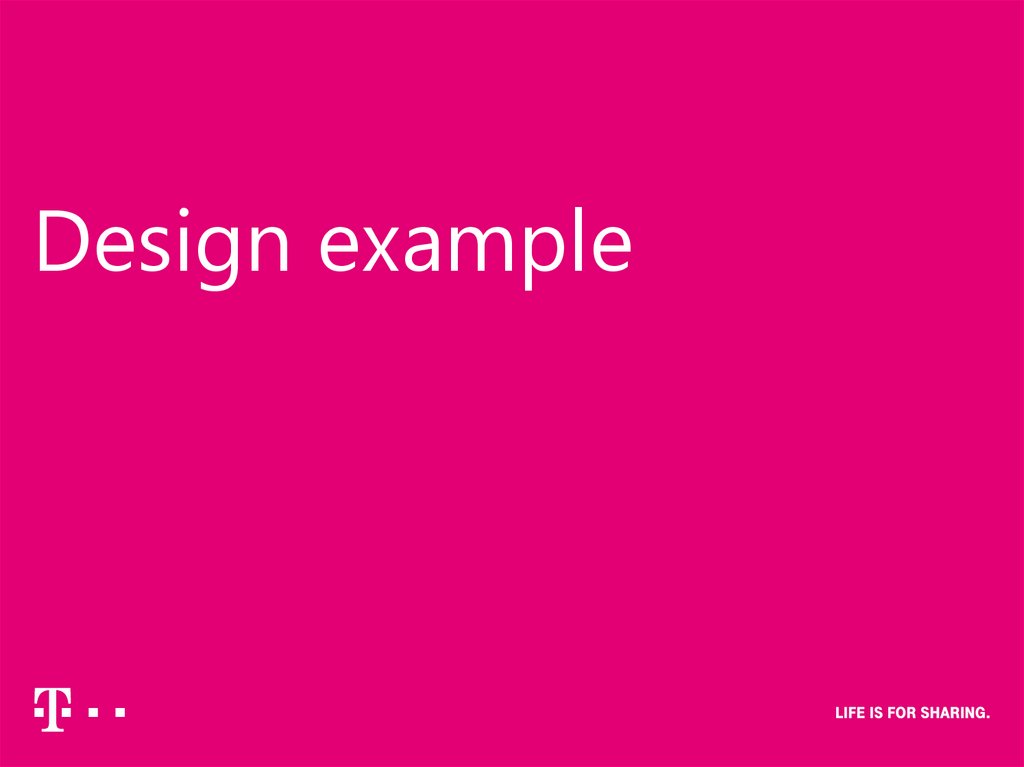




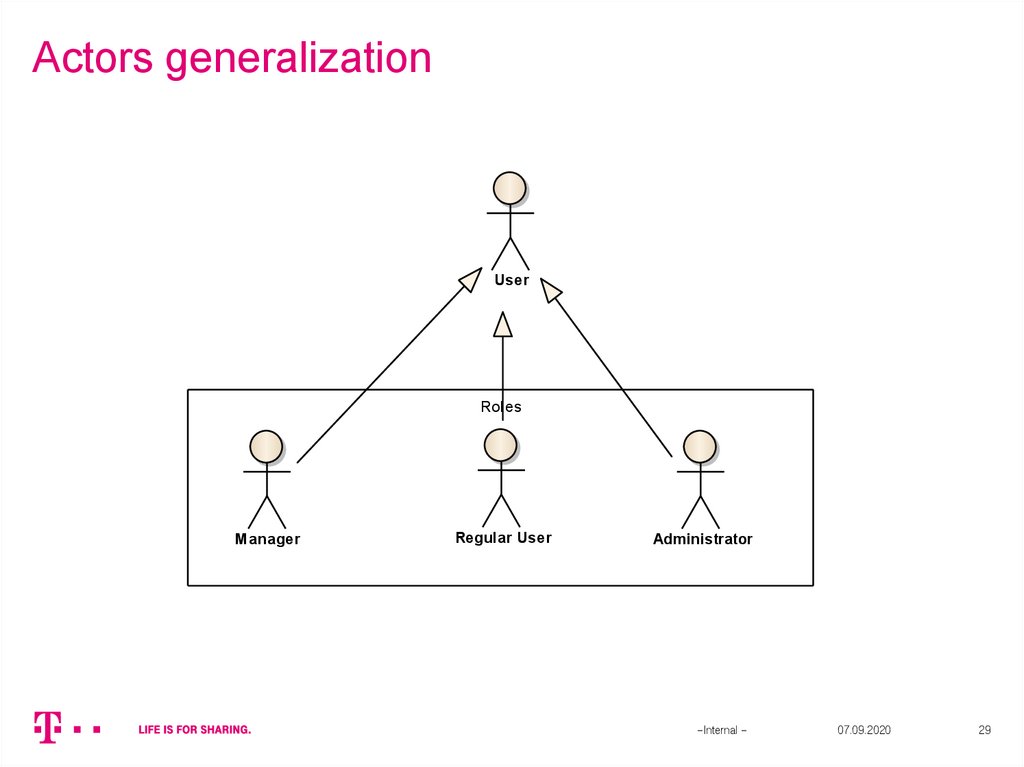







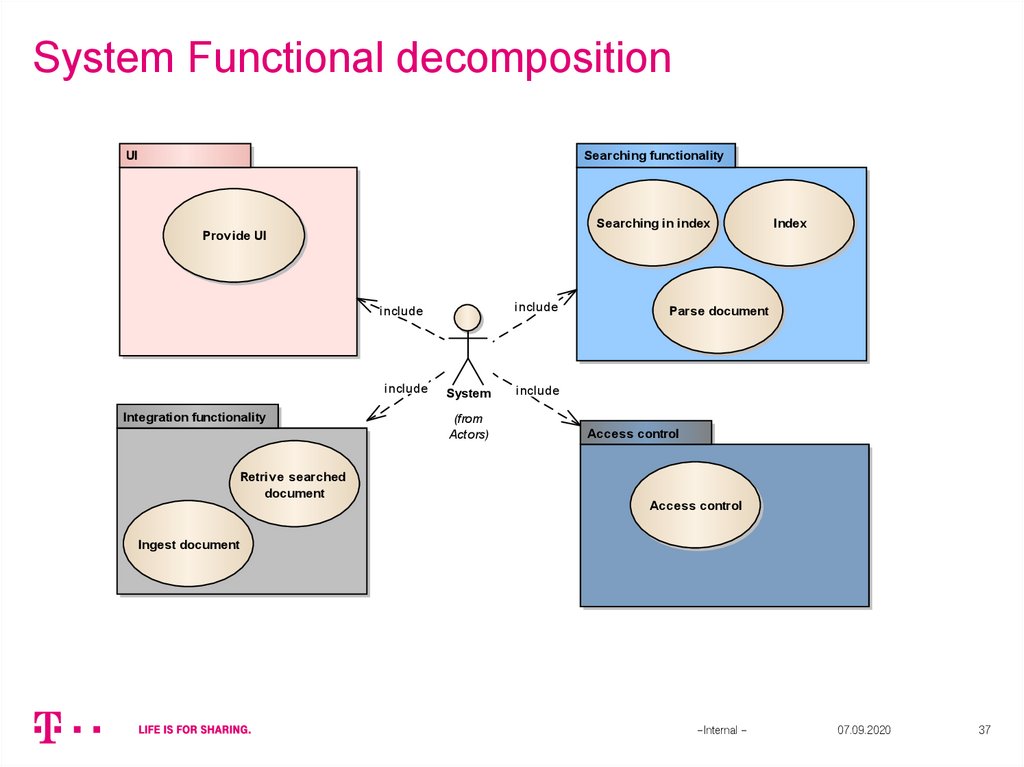



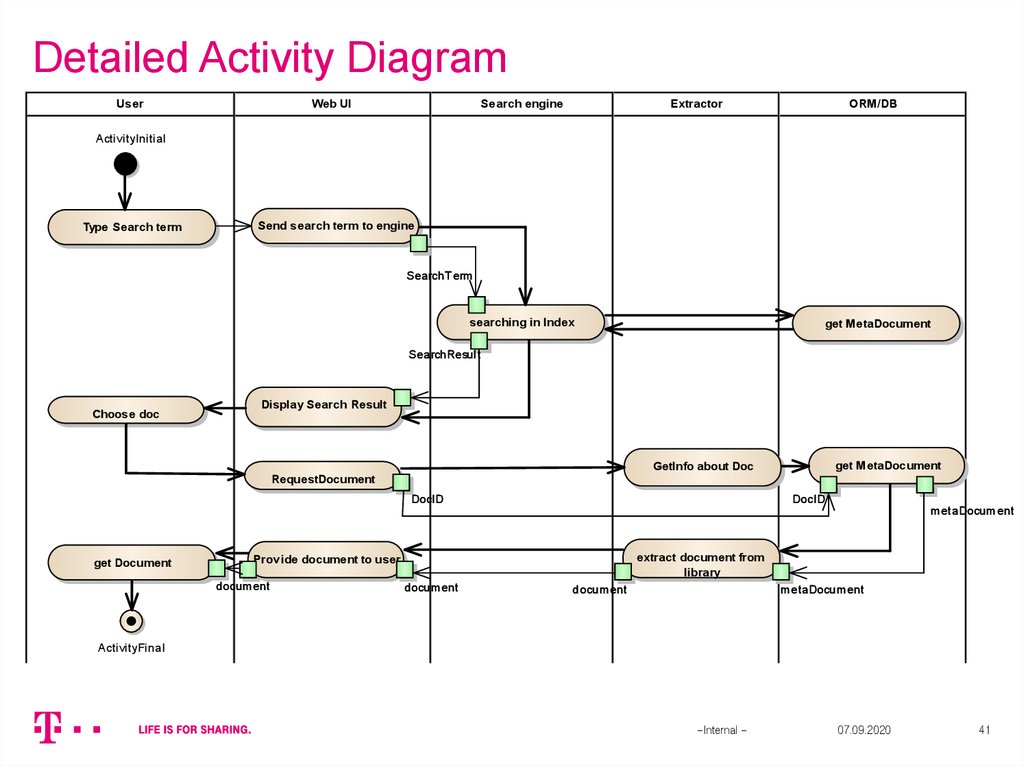

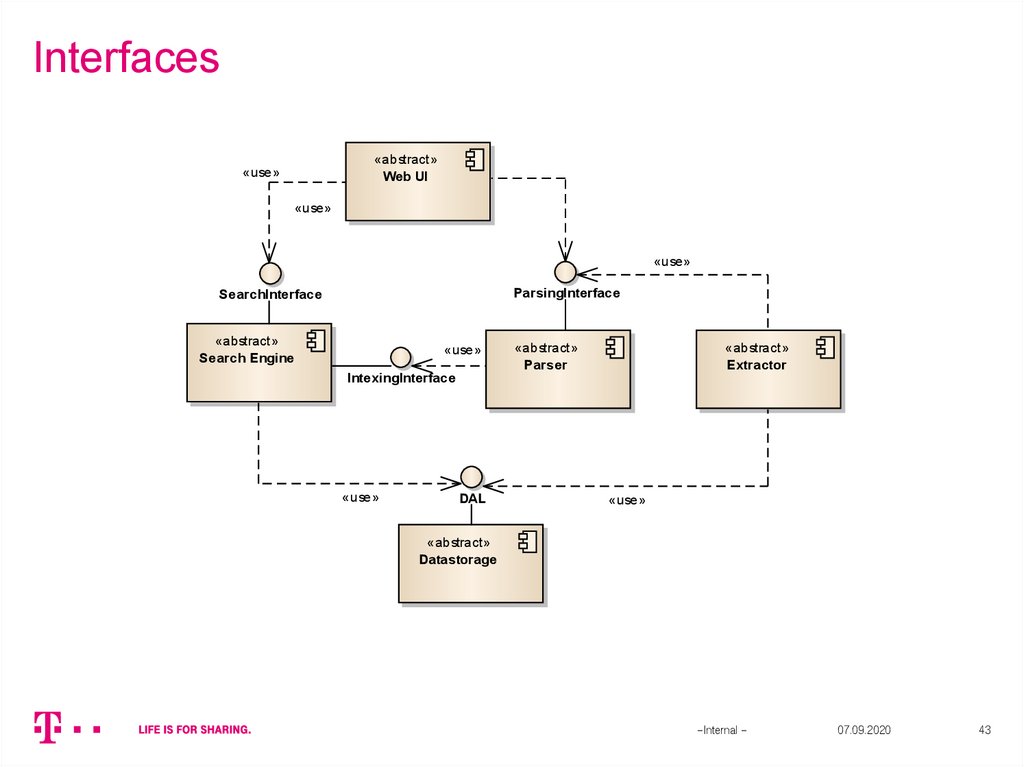




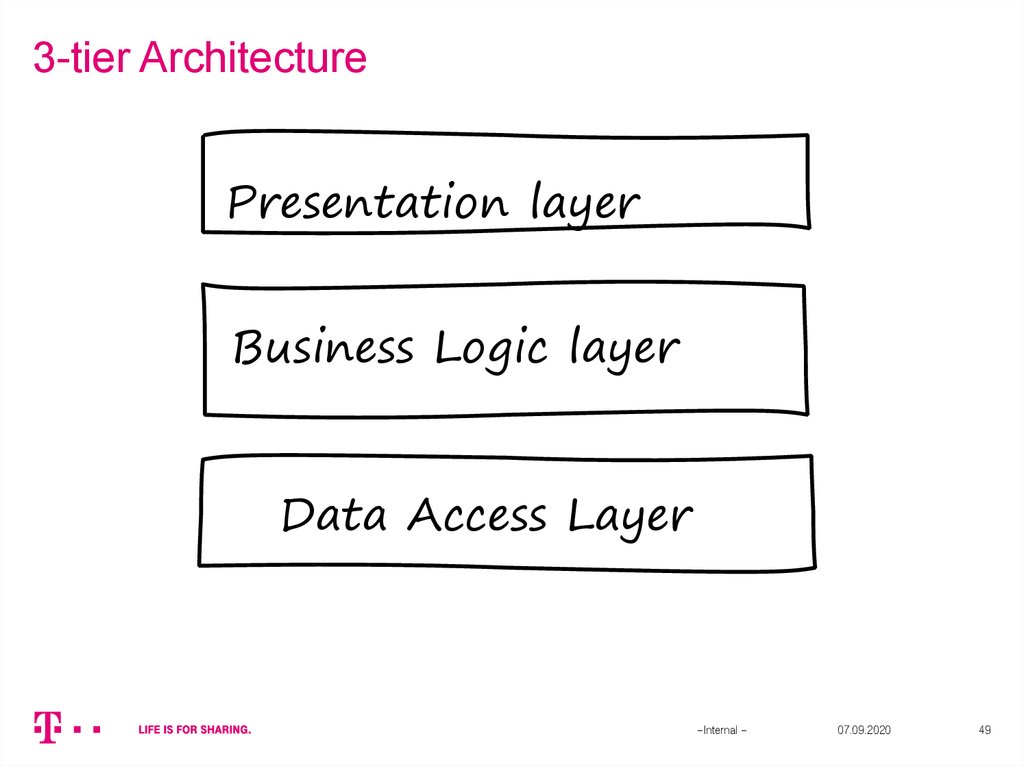







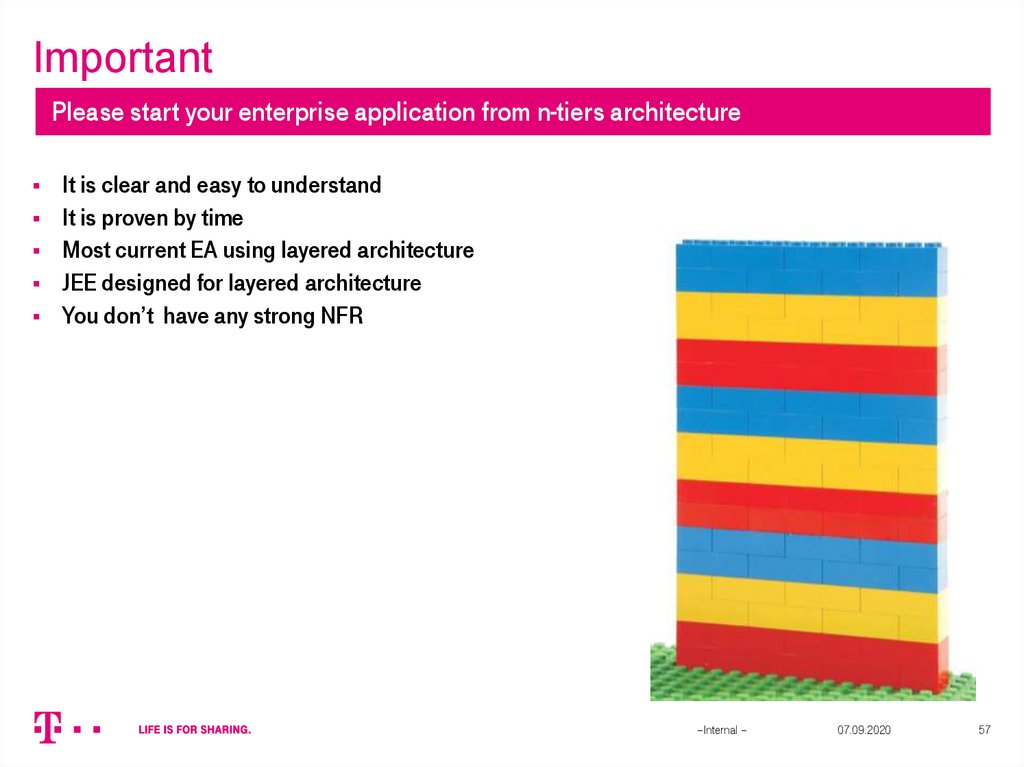

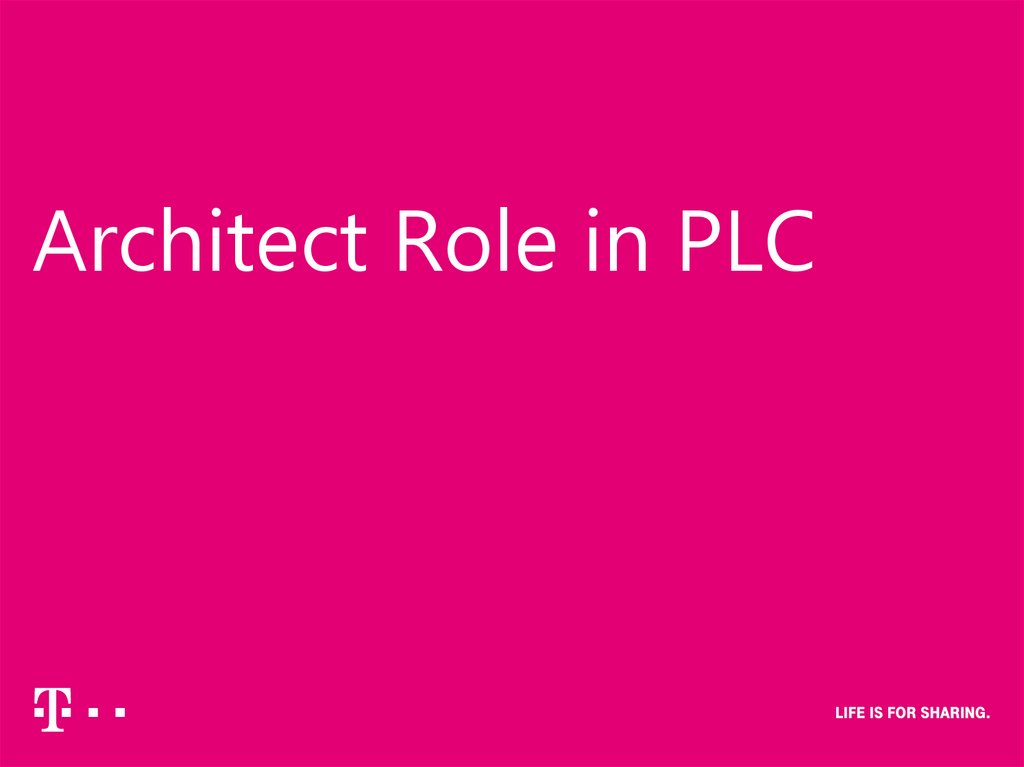




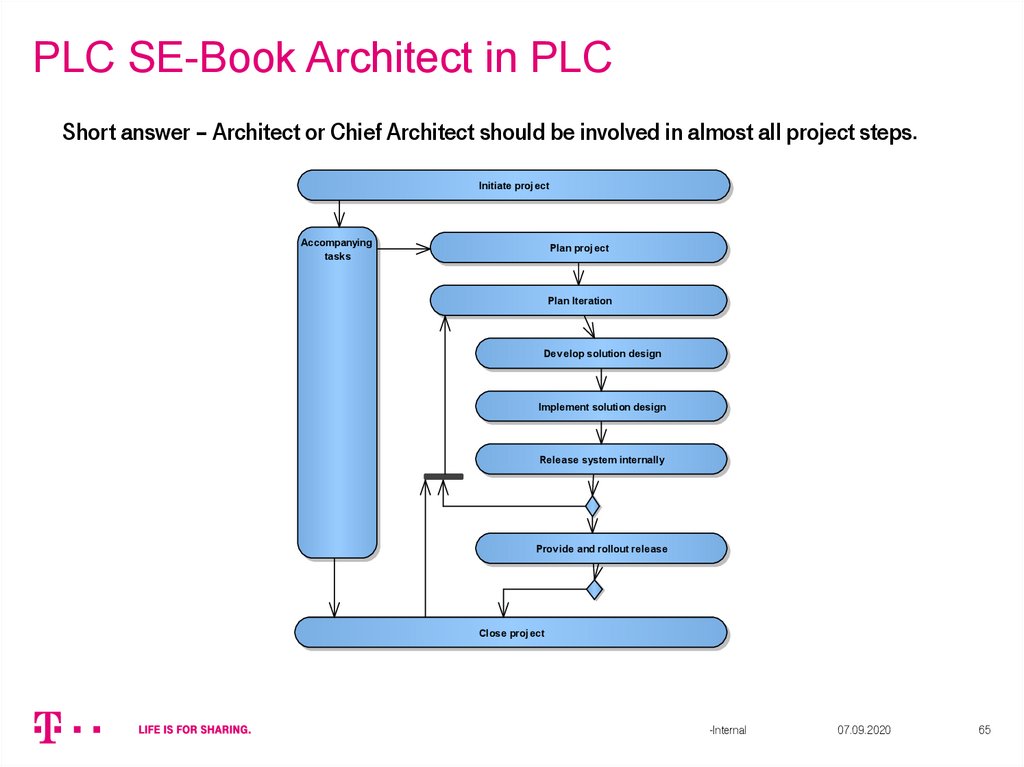


















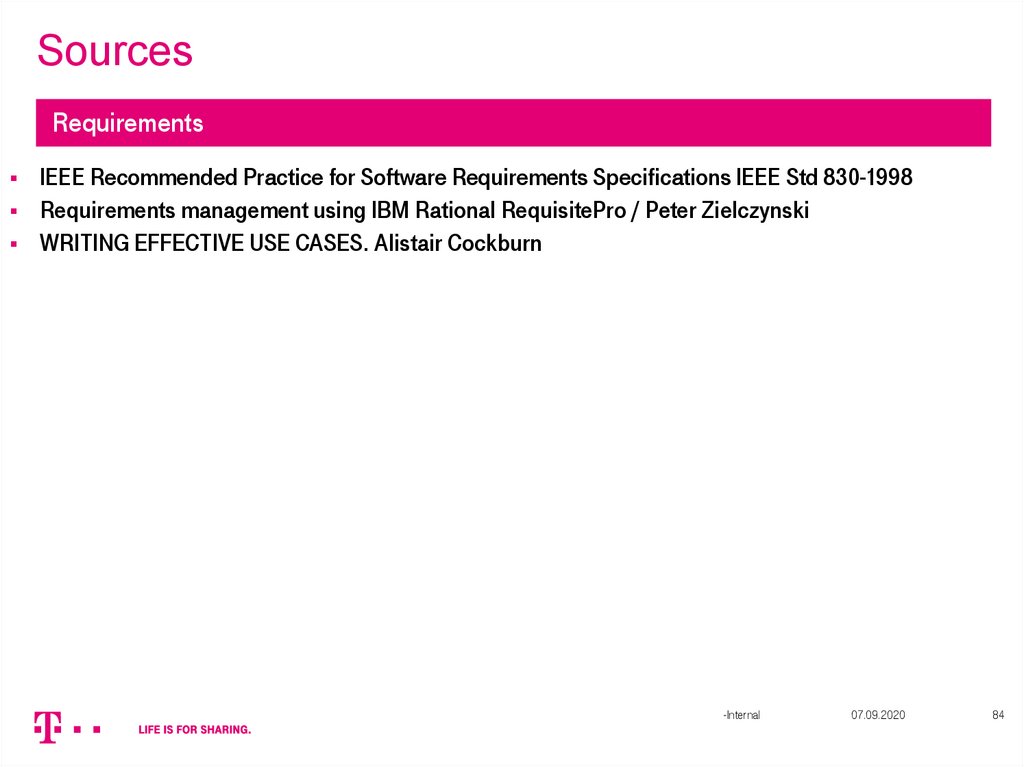

 software
software








